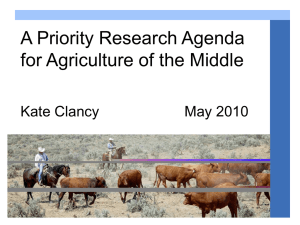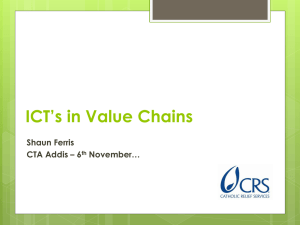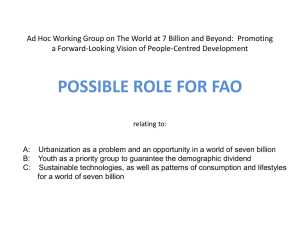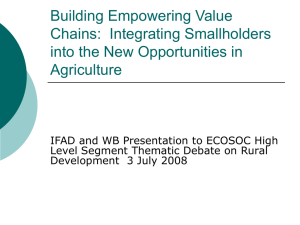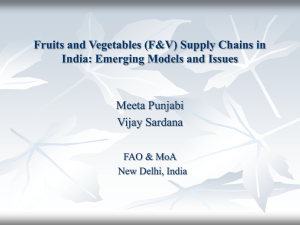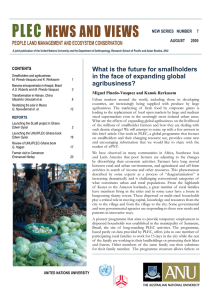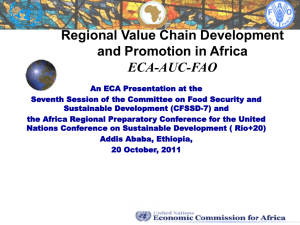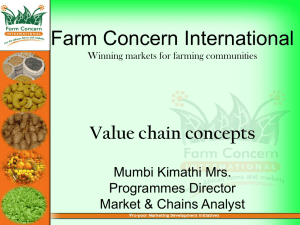conclusions and recommendations
advertisement
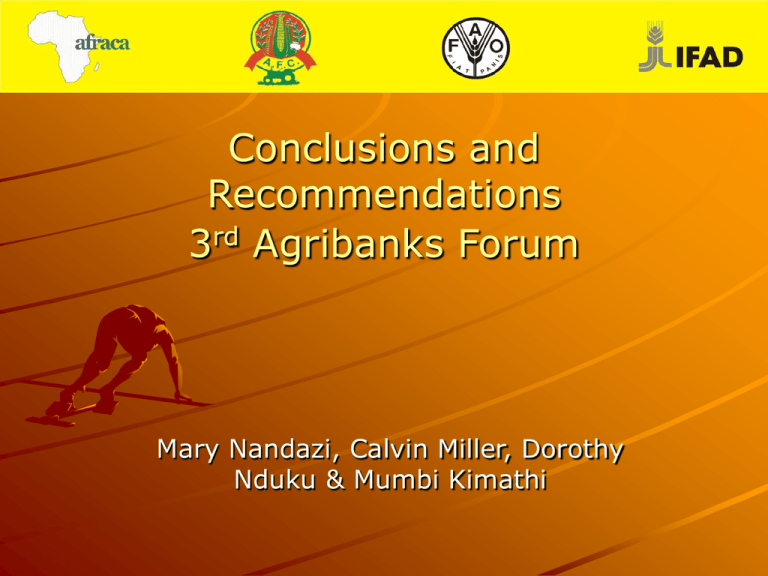
Conclusions and Recommendations 3rd Agribanks Forum Mary Nandazi, Calvin Miller, Dorothy Nduku & Mumbi Kimathi The Development Mission As shown in the FAO Right to Food Day presentation, access to safe and nutritious food for all is critical and increased attention on urban and rural poor is required. Kenya’s VP and Min. of Agriculture highlighted increased Government’s recognition of the role of rural farming economies and its willingness to participate in agricultural value chains Challenges inhibit agricultural growth; workshop participants are challenged to focus on solutions…particularly rural finance and value chain financing interventions Premises Agriculture is important to Africa – Agriculture is 70% of Kenya’s employment and 25% of GDP (Vice President, Kenya) Farmers are interested becoming business persons; a market orientation is key The role of women is agriculture is critical and must receive attention The active engagement and commitment of the private sector is required for value chain development; interventions must include, learn from, partner with and strengthen the private sector’s investment in agriculture and agribusiness and their interaction with small farmers Lessons and Conclusions Huge milestones have been covered in years evolving value chains from plantations dominated to value chains integrating smallholders Successful models aimed at increasing the participation of smallholders along dynamic value chains as highlighted by Farm Concern Intl’, Technoserve, Actis, Kafo, ADB Ghana Infrastructure plays a major role in agricultural value chains, and must be addressed The poor state of traditional markets in most countries is still a major challenge for stable value chains Lessons and Conclusions Strong SACCO Networks can play a role in financing and empowering many smallholders for integrating into value chains Value chain analysis is an important part of understanding chains and relationships and how to best target work in them, especially for rural farmers A holistic approach and partnership are required to build the capacity and services needed to integrate small farmers into commercial value chains. Lessons and Conclusions Risk mitigation – is critical in value chain finance – commodity management is central to address product quantity, quality and weight – commodity management (ex. ACE) for control, monitoring, and inspection services are needed around the world – risk mitigation begins with “knowing your client” – combining good production practices and secure markets for clients, good loan analysis and good value chain and market understanding An emphasis must be given to efficiency – technical, economic and allocation of resources Diversification of products and niche markets is important to reduce risk and to address opportunities Lessons and Conclusions Business development services are required to make small farmers bankable and have access to profitable value chains – many successful facilitation models exist (ex. BDS Kenya, Farm Concern, CEPCO, BASIX, DrumNet....) Skill and capacity building – addressing needs of small farmers in a collaborative and efficient manner Farmers have to be trained to understand commercial agriculture, take necessary measures to meet buyer specifications; most will be willing, some will not Farmers have the potential, we need to facilitate its realization Lessons and Conclusions Investment resources are needed and comes from multiple sources; successful models include: – – – – Savings: SACCOS, banks Loans: Banks, MFIs, investment companies Equity and venture capital: ACTIS, Technoserve Shared risk models Equity and quasi-equity sources are especially important for agribusiness finance. Intermediaries play an important role and need to be considered when financing the supply chain Lessons and Conclusions Experiences from the “Middlemen” passion fruit, processing into pulp and selling to large buyers Bernard Maina, aggregation and sales of tomatoes and French beans Financial Constraints of intermediaries brought to light. Both working and fixed capital required Play important role as value chain actors Value Chain Finance Recommendations and Issues to Address in the Future Commodity Management (ej. ACE) is an area for further work –linking with programs of smallholders through NGOs and others Technology should be developed and shared – expanding models such as M-Pesa and E-choupal Skill and capacity building is required – addressing needs of small farmers in a collaborative and efficient manner – addressing needs of governments, MFIs and development agencies to learn – cross-exchange, web exchange and interaction to learn from each other must be pursued Recommendations and Future Issues A standard platform and guidelines – is important to collaborate (with donor support) to build a common set of standards and tools for value chain finance, such as Microfin (for planning) and the Microfinance Standards (for analysis) and Microbanker (for MIS) AFRACA, FAO and others are platforms for collaboration and collaborative learning – a joint effort is needed by all to grow and learn together Recommendations and Future Issues Value chain finance offers an answer to addressing agricultural and agribusiness finance; the way forward in perfecting and promoting it begins with us. Thank you!!
